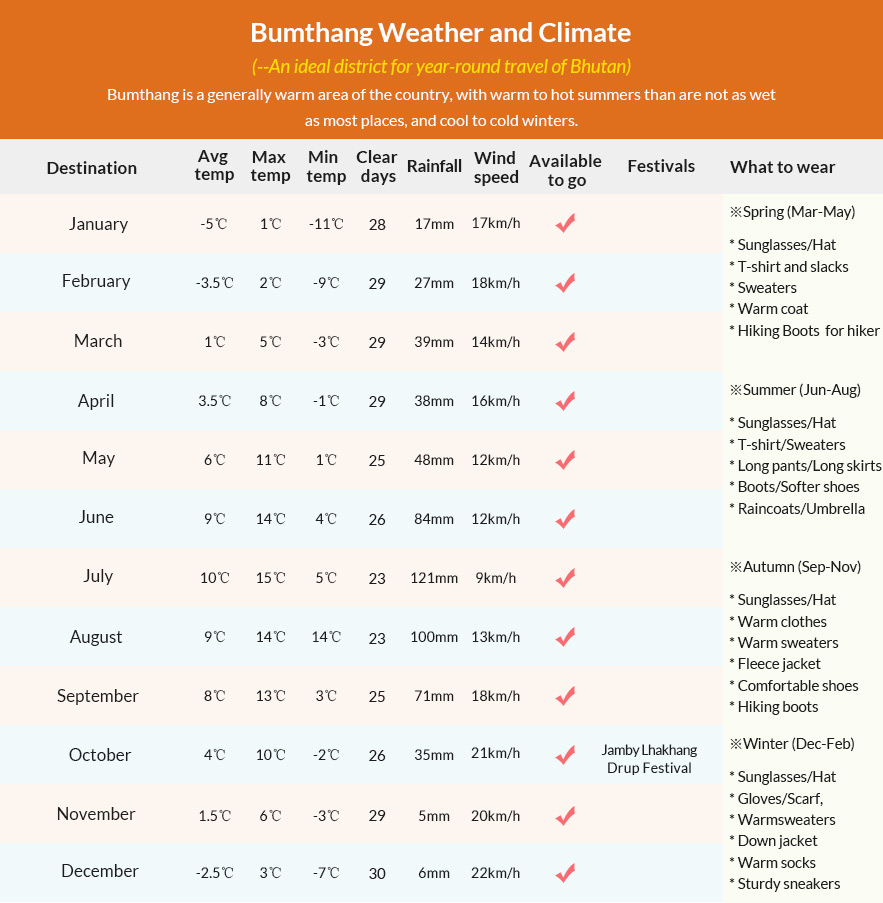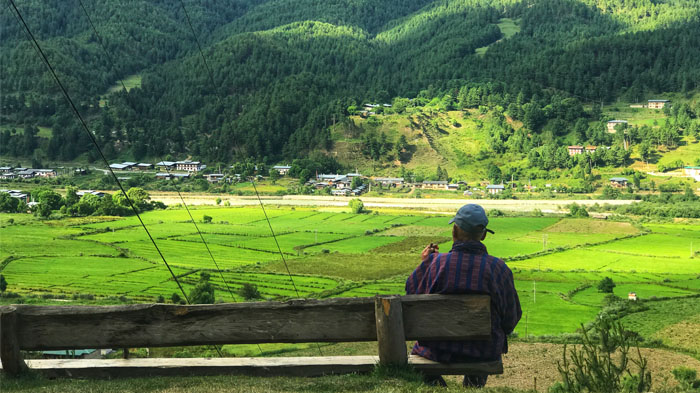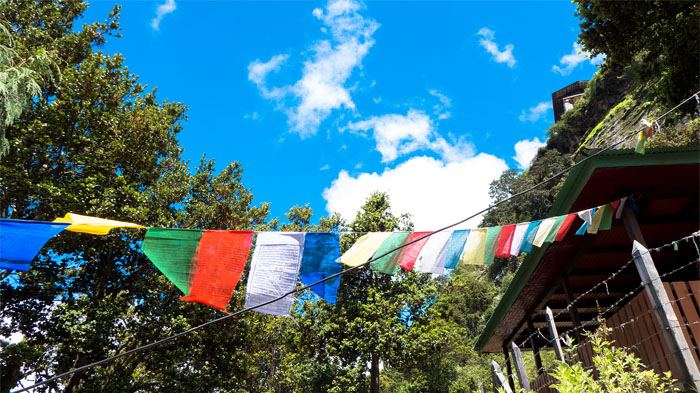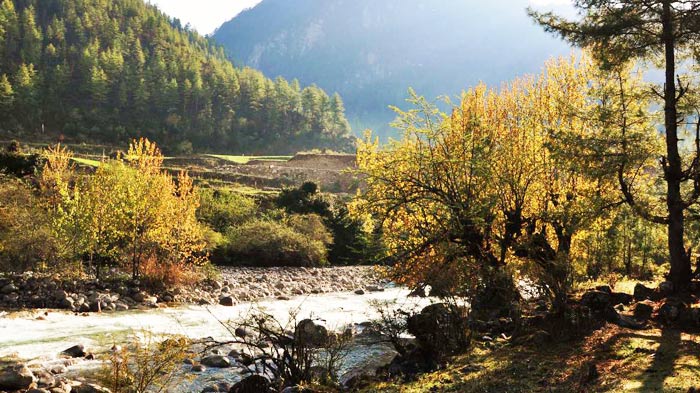
Weather and Climate of Bumthang
Bhutan lies on the southern edge of the eastern Himalayas, and ranges in altitude from the high mountains at more than 7,000 meters to just a few meters above sea level in the far south, along the border with India. This means that the climate and weather of the country is hard to generalize, as the altitude changes can greatly influence the climate across the kingdom. Overall, Bhutan has a four-season climate, with a monsoon season in the summer months.
Bumthang Dzongkhag in central Bhutan has more in common with the districts in the east of Bhutan than in the west, and has a generally warm climate, though with chilly winters and hot humid summers. Altitudes range from as low as 2,600 meters to as high as 4,500 meters across the district, which gives rise to a varied climate system within the Dzongkhag itself. As a whole, Bumthang is a generally warm area of the country, with warm to hot summers than are not as wet as most places, and cool to cold winters, which get colder the higher up you go.
What is Bumthang weather and climate by month?
Bumthang Weather Guide
 Table of Bumthang Weather Guide
Table of Bumthang Weather Guide
Spring (March - May)
Average daytime temperature: 7°C
Average nighttime temperature: -3°C
Average wind speed: 15km/h
Average precipitation/month: 40mm
Clear days/month: 25
March in Bumthang is a slightly warmer month, with an average mean temperature across the district of around -2.4°C and highs of up to 5°C on average. Minimum temperatures average around -9.8°C from north to south of the district, and with as much as 41mm of rain, the humidity is already starting to exceed 44 percent.
 The crops are growing vigorously in April.
The crops are growing vigorously in April.
April is the real start of spring in Bumthang, with temperatures rising on average to around 1 degree across the district. Average highs can reach up to around 7.5°C with lows averaging around -4.9°C at night. Humidity in April is much higher now, hitting around 52 percent, with up to 20mm of rainfall on average throughout the month.
May sees an increase in temperatures on average to around 4.1°C as a mean across the district, with lows at night averaging around -1°C and highs during the day getting up to as high as 9.5°C on average. With around 66mm of rainfall throughout the month across the district, the humidity increase to almost 60 percent on average, making May a cool yet humid month as the monsoon rains approach.
Summer (June - August)
Average daytime temperature: 14°C
Average nighttime temperature: 5°C
Average wind speed: 18km/h
Average precipitation/month: 104mm
Clear days/month: 23
June is the start of the monsoon season, and as the temperatures rise to an average mean of around 7.7°C, the rainfall also increases to as high as 78mm for the entire month. Humidity is high in June at around 68 percent on average, with high temperatures averaging up to 12.3°C and lows of just 3.9°C at night on average.
 The blue sky and white clouds in summer of Bumthang
The blue sky and white clouds in summer of Bumthang
July is the wettest month of the year in Bumthang, with an average of around 114mm of rain throughout the month, and a humidity level that peaks at around 74 percent. Temperatures are not much higher than in June on average, with the mean temperature hitting around 8.7°C. High temperatures can get up to around 13°C on average, with the average low across the district only getting up to around 5.3°C.
August in Bumthang is one of the two wettest months of the year, with around 94mm of rain throughout the month on average. Humidity is still high in August, with an average of around 73 percent, despite having less rainfall than in July. Average temperatures can hit around 8.2 degrees as a mean temperature, with highs of up to 12.6°C and lows at night of only 4.8°C on average.
Autumn (September - November)
Average daytime temperature: 9°C
Average nighttime temperature: 2°C
Average wind speed: 16km/h
Average precipitation/month: 31mm
Clear days/month: 27
As September rolls in, the weather is cooling down across the district, and an average mean temperature of only 6°C is normal for the month. High temperatures of up to 11.4°C and lows of down to 2.3°C are common across the area. Rainfall is also a lot lower, with only around 53mm of rain for the month and humidity levels dropping to around 69%.
 The beautiful scenery of Bumthang in autumn appears thousands of travelers.
The beautiful scenery of Bumthang in autumn appears thousands of travelers.
October is the real start of autumn in Bumthang, and the humidity drops to below 50 percent and the rainfall also drops to just 30mm for the entire month as the weather dries up the landscape and prepares for the dry season. Average mean temperatures are only around 1.3°C in October, with high temperatures of just 8.2°C on average and average lows at night of down to -4.9°C.
The cooler weather really comes in as November comes around, with mean temperatures of around -2.5°C and highs of only 7.1 degrees for the district on average. Nightly temperature averages are often as low as -10 degrees in November, and with virtually no rain at all, humidity is down to less than 30 percent, mostly from the rivers and streams instead of the rainfall.
Winter (December - February)
Average daytime temperature: 3°C
Average nighttime temperature: -5°C
Average wind speed: 19km/h
Average precipitation/month: 9mm
Clear days/month: 29
December is the end of the year and the start of the winter season in Bumthang, and often sees no rainfall at all on average across the district. Temperatures drop drastically as December comes and winter sets in, with an average mean of only -5.3 degrees. Highs through December average around 5.1°C for the district, with an average low that drops down to around -14 degrees.
 Bhutang in winter with its pure white blanket of snow, has its own beauty.
Bhutang in winter with its pure white blanket of snow, has its own beauty.
January can be a changeable month depending on where in Bumthang you are traveling, and temperatures can range from as low as -16°C in the higher mountains to as high as 2.4°C in the valleys to the south. Overall, the average temperature across the district in January is usually around -7°C. Humidity is low in Bumthang District in January, and with only 2-3mm of rain, it is to be expected that January is a dry and cold month across the district.
February does see an increase in the rainfall in Bumthang, with around 15mm falling throughout the month, and a humidity of more than 35%. Temperatures average around -6.6°C for the month, with highs of up to 2.3°C on average and average lows that can drop to around -15°C. When is the best time to visit Bumthang?
Bumthang is a four season region of Bhutan, though with the variance of altitudes and landscapes, the monsoon season is harsher in the south of the Dzongkhag than in the mountainous north. Spring and autumn are still the best times to visit this unique district, which has some of the greatest trekking areas for the region in the north of the central region of Bhutan. The weather is cool and dry and perfect for trekking and touring, with clear skis and bright sunshine for most of the days in each month.
>> Check the detailed weather statistic and find out your favorable time to visit Bhutan
>> Check the Bhutan Trekking Season: when is the best time to trek Bhutan?
Winter is mild and relatively warm on average; though the variance between the north and south of the district can make the mean temperatures seem a little colder than they actually are. The cooler south is mild and comfortable, while in the mountainous north, temperatures can drop to well below freezing, even in the daytime, and the winds are chill and biting.
Summer is the monsoon, and while it can get a little damp and humid, there is not as much rainfall as in the other central districts of Bhutan. Lower rainfall, however, does not mean lower humidity, and while temperatures may not get up to the levels of Thimphu or Punakha, humidity can reach a very high percentage, making it sticky and clammy through July and August.
Is Bumthang weather in Jul. and Aug. too rainy or Dec. and Jan. too cold to visit?
What is the monsoon season like from late June to middle Sep. in Bumthang?
The monsoon season in Bumthang is actually relatively mild for an area in central Bhutan. With high rainfall averaging only up to 114mm of rain for even the wettest art of the month, the lower rainfall means that there is not as much muddy areas and wet slippery trails, so there are treks that can be done even in the monsoon areas, especially in the higher regions closer to the mountains of the Himalayas. - See more Bhutan tours here.
 Trekking enjoyably to the woods of the lovely Bumthang area.
Trekking enjoyably to the woods of the lovely Bumthang area.
Is it possible to visit Bumthang during the monsoon season?
Yes, visiting in the monsoon season is possible, and even preferable to visiting other places such as Punakha and Paro, or even the capital at Thimphu, as there is less rainfall and cooler temperatures on average. There are areas of Bumthang that can reach highs of around 22-24 degrees in the hottest month of July, but for the most part, these are few, and mostly in the farthest south of the Dzongkhag.
What is the winter like from December to February in Bumthang?
Winter in Bumthang is generally cool to cold, depending on which part of the Dzongkhag you are traveling in. The southern area is filled with alpine valleys at altitudes of around 2,900 meters, which are warmer than the north, where temperatures can reach down as low as -15 degrees at night. AS you had north from the valleys around Jakar, you can get some great views of the snow-capped mountains of the eastern Himalayas in the winter months from December to February, and the clear skies and bright sunshine makes for some great photos of the peaks of the high mountains.
Besides the city tour what else we can do in Bumthang winter?
Bumthang is one place in Bhutan where you can trek throughout the year, and this includes the winter months. As the major treks in Bumthang, the Owl trek and the Bumthang Cultural trek, are done at the lower altitudes of the district, around the main valleys that surround Jakar and the Bumthang Valley, trekking is still possible, with clear skies, bright sunny days, no rain, and though cold, not as cold as the higher mountains.
Conclusion
Bumthang is one of changing temperatures and variable climates, which makes it an ideal district for year-round travel. The higher mountainous area of the north of Bumthang, which borders with Tibet, is best visited from April to October, when the weather is not as cold. And with little rain in the mountains, even in the monsoon season, the trip can even be done in the summer months. Winter may be cold in the north, with temperatures dropping to below -15 degrees, but in the south, the winter is milder, with average temperatures that are still above freezing, even at night. Winter treks in the southern valleys around Jakar are also a great way to spend the winter months when trekking in other areas is no longer possible.

I am a tour guide in Tibet an was Born in Kham Tibet, I am the father of 2 little girls, bachelor's degree. I have more than 7-years experience of being a tour guide in Tibet. I am a warm, friendly, knowledgeable and attractive guy.


.jpg)



0 Comment ON "Weather and Climate of Bumthang"